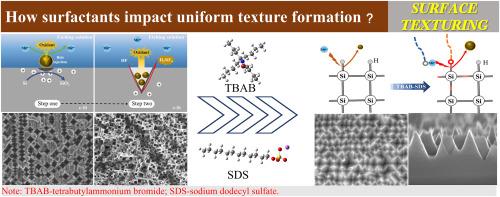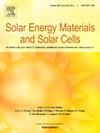Silicon surface texturing via TBAB-SDS composite additives enhanced copper-assisted chemical etching
IF 6.3
2区 材料科学
Q2 ENERGY & FUELS
引用次数: 0
Abstract
Uneven etching and low fabrication efficiency impede the large-scale applications of copper-assisted chemical etching (Cu-ACE) for texturing light-trapping structures on the surface of silicon wafers. To address this, a composite additive composed of tetrabutylammonium bromide (TBAB) and sodium dodecyl sulfate (SDS) was introduced into the Cu-ACE system. The results indicated that TBAB accelerated the etching rate and improved the texturing uniformity, while SDS enlarged the size of the formed structures and enhanced their ultraviolet light absorption efficiency. The prepared inverted pyramid structure reduced the reflectivity of the silicon wafer surface to 3.8 %, thus exhibiting efficient light-trapping capabilities. The etching evolution under various TBAB concentrations and different HF/H2O2 ratios was studied by characterizing the surface contact angle and copper deposition morphology. The results indicated that electrostatic attraction between TBAB and dangling bonds on the silicon wafer surface enhanced material transfer at the reaction interface and changed the electron distribution around dangling bonds, thus facilitating the catalytic metal attack on these bonds. The copper ion reactivity was decreased due to complexation between the dissociated alkyl sulfate ions of SDS and copper ions, which favored the deposition of larger copper nanoparticles during etching, thereby increasing the size of structures. This research offers valuable insights to enable the large-scale applications of Cu-ACE.

通过 TBAB-SDS 复合添加剂增强铜辅助化学蚀刻的硅表面纹理形成
蚀刻不均匀和制造效率低阻碍了铜辅助化学蚀刻(Cu-ACE)在硅晶片表面纹理捕光结构方面的大规模应用。为解决这一问题,我们在 Cu-ACE 系统中引入了由四丁基溴化铵(TBAB)和十二烷基硫酸钠(SDS)组成的复合添加剂。结果表明,TBAB 加快了蚀刻速度并改善了纹理的均匀性,而 SDS 则扩大了所形成结构的尺寸并提高了其紫外线吸收效率。制备的倒金字塔结构将硅晶片表面的反射率降低到 3.8%,从而表现出高效的光捕获能力。通过表征表面接触角和铜沉积形态,研究了不同 TBAB 浓度和不同 HF/H2O2 比率下的蚀刻演化过程。结果表明,TBAB 与硅片表面悬挂键之间的静电吸引增强了反应界面上的物质转移,并改变了悬挂键周围的电子分布,从而促进了对这些键的催化金属攻击。由于 SDS 中解离的硫酸烷基离子与铜离子之间的络合作用,铜离子的反应活性降低,这有利于在蚀刻过程中沉积更大的纳米铜粒子,从而增大结构的尺寸。这项研究为 Cu-ACE 的大规模应用提供了宝贵的启示。
本文章由计算机程序翻译,如有差异,请以英文原文为准。
求助全文
约1分钟内获得全文
求助全文
来源期刊

Solar Energy Materials and Solar Cells
工程技术-材料科学:综合
CiteScore
12.60
自引率
11.60%
发文量
513
审稿时长
47 days
期刊介绍:
Solar Energy Materials & Solar Cells is intended as a vehicle for the dissemination of research results on materials science and technology related to photovoltaic, photothermal and photoelectrochemical solar energy conversion. Materials science is taken in the broadest possible sense and encompasses physics, chemistry, optics, materials fabrication and analysis for all types of materials.
 求助内容:
求助内容: 应助结果提醒方式:
应助结果提醒方式:


